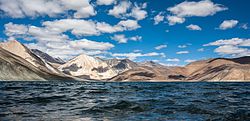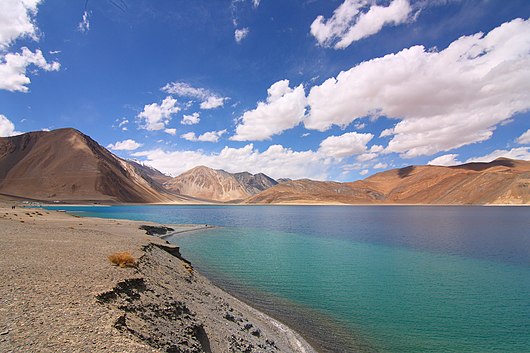पांगोंग त्सो
| Pangong Tso | |
|---|---|
 | |
 Pangong Tso  Pangong Tso  Pangong Tso | |
| स्थान | लेह ज़िला (लद्दाख़, भारत), Rutog County (Tibet, चीन) |
| निर्देशांक | 33°43′04.59″N 78°53′48.48″E / 33.7179417°N 78.8968000°Eनिर्देशांक: 33°43′04.59″N 78°53′48.48″E / 33.7179417°N 78.8968000°E |
| प्रकार | Soda lake dimictic lake (east basin)[1] cold monomictic lake (west basin)[] |
| द्रोणी देश | India |
| अधिकतम लम्बाई | 134 कि॰मी॰ (440,000 फीट) |
| अधिकतम चौड़ाई | 5 कि॰मी॰ (16,000 फीट) |
| सतही क्षेत्रफल | approx. 700 कि॰मी2 (7.5×109 वर्ग फुट) |
| अधिकतम गहराई | 330 ft. (100 m) |
| सतही ऊँचाई | 4,225 मीटर (13,862 फीट)[2] |
| हिमीकरण | during winter |
| Pangong Tso | |||||||||
|---|---|---|---|---|---|---|---|---|---|
| चीनी नाम | |||||||||
| पारम्परिक चीनी | 班公錯 | ||||||||
| सरलीकृत चीनी | 班公错 | ||||||||
| |||||||||
| Tibetan name | |||||||||
| Tibetan | སྤང་གོང་མཚོ | ||||||||
| |||||||||
| Tsomo Nganglha Ringpo | |||||||||
|---|---|---|---|---|---|---|---|---|---|
| चीनी नाम | |||||||||
| पारम्परिक चीनी | 錯木昂拉仁波 | ||||||||
| सरलीकृत चीनी | 錯木昂拉仁波 | ||||||||
| |||||||||
| वैकल्पिक चीनी नाम | |||||||||
| पारम्परिक चीनी | 哥木克哥那喇令错 | ||||||||
| |||||||||
| Tibetan name | |||||||||
| Tibetan | མཚོ་མོ་ངང་ལྷ་རིང་པོ | ||||||||
| |||||||||

पांगोंग त्सो (या पांगोंग झील; त्सो: लद्दाख़ी में झील) हिमालय में एक झील है जिस्की उचाई लगभग 4500 मीटर है। यह 134 किमी लंबी है और भारत के लद्दाख़ से तिब्बत पहूँचती है। जनवादी गणराज्य चीन में झील की दो तिहाई है। इसकी सबसे चौड़ी नोक में सिर्फ़ 8 कीमी चौड़ी है। शीतकाल में, नमक पानी होने के बावजूद, झील संपूर्ण जमती है।
लेह (भारत) से पांगोंग त्सो एक पाँच घंटे के गाड़ी का भ्रमण है, जिसका सबसे अधिक एक खुरदरा और नाटकीय पहाड़ी रस्ता में है।
छायाचित्र

पांगोंग त्सो के पास टेंट

पांगोंग त्सो

पांगोंग त्सो के पास की पहाड़ियाँ
बाहरी कड़ियाँ
- ↑ Wang, M., Hou, J. and Lei, Y., 2014. Classification of Tibetan lakes based on variations in seasonal lake water temperature. Chinese Science Bulletin, 59(34): 4847-4855.
- ↑ Dortch et al., Catastrophic partial drainage of Pangong Tso (2011), पृ॰ 111.
- ↑ India, Ministry of External Affairs, संपा॰ (1962), Report of the Officials of the Governments of India and the People's Republic of China on the Boundary Question, Government of India Press, Chinese Report, Part 1, पृष्ठ 4–5. (Report).
The location and terrain features of this traditional customary boundary line are now described as follows in three sectors, western, middle and eastern. ... From Ane Pass southwards, the boundary line runs along the mountain ridge and passes through peak 6,127 (approximately 78° 46' E, 38° 50' N) [sic] and then southwards to the northern bank of the Pangong Lake' (approximately 78° 49' E, 33° 44' N). It crosses this lake and reaches its southern bank at approximately 78° 43' E, 33° 40' N. Then it goes in a south-easterly direction along the watershed dividing the Tongada River and the streams flowing into the Spanggur Lake until it reaches Mount Sajum. - ↑ Lt Gen HS Panag (Retd) (4 June 2020). "India's Fingers have come under Chinese boots. Denial won't help us". The Print.
सन्दर्भ त्रुटि: "lower-alpha" नामक सन्दर्भ-समूह के लिए <ref> टैग मौजूद हैं, परन्तु समूह के लिए कोई <references group="lower-alpha"/> टैग नहीं मिला। यह भी संभव है कि कोई समाप्ति </ref> टैग गायब है।








